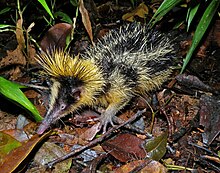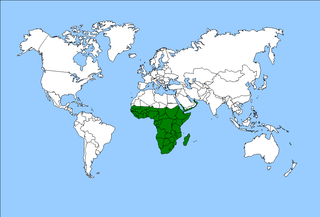
The Afrotropical realm is one of the Earth's eight biogeographic realms. It includes Sub-Saharan Africa, the southern Arabian Peninsula, the island of Madagascar, and the islands of the western Indian Ocean. It was formerly known as the Ethiopian Zone or Ethiopian Region.
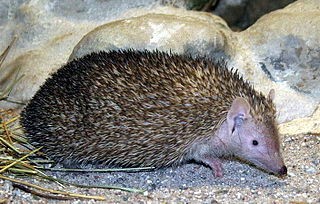
The clade Afrosoricida contains the golden moles of Southern Africa, the otter shrews of equatorial Africa and the tenrecs of Madagascar. These three groups of small mammals were for most of the 19th and 20th centuries regarded as a part of the Insectivora or Lipotyphla, but both of those groups, as traditionally used, are polyphyletic.

A tenrec is a mammal belonging to any species within the afrotherian family Tenrecidae, which is endemic to Madagascar. Tenrecs are a very diverse group; as a result of convergent evolution, some resemble hedgehogs, shrews, opossums, rats, and mice. They occupy aquatic, arboreal, terrestrial, and fossorial environments. Some of these species, including the greater hedgehog tenrec, can be found in the Madagascar dry deciduous forests. However, the speciation rate in this group has been higher in humid forests.

The hairy-eared dwarf lemur, or hairy-eared mouse lemur, is one of the most scarcely known lemurs. A. trichotis is a nocturnal lemur that is endemic to Madagascar. It was originally named by Albert Günther in 1875 as Cheirogaleus trichotis as part of the Cheirogaleidae family, or the dwarf lemurs. In 1967 Petter-Rousseaux and Petter reassigned the lemur to its own genus and is the now only member of the genus Allocebus. The hairy-eared dwarf lemur was thought to be extinct until its rediscovery in 1989 in a northeastern primary lowland rainforest. The population of these mammals is shown to be severely decreasing and largely fragmented throughout Northern and Eastern Madagascar rainforests; most likely due to hunting, trapping, slash-and-burn agriculture as well as habitat fragmentation.
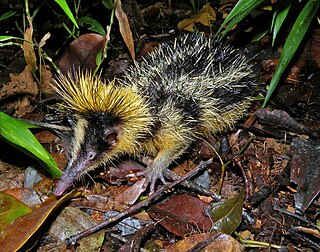
The lowland streaked tenrec is a small tenrec found in Madagascar. It belongs to the family Tenrecidae in the order Afrosoricida, and more specifically to the subfamily of the spiny tenrecs Tenrecinae. Its natural habitats are in tropical lowland rain forests in northern and eastern parts of Madagascar.

The black-and-white mannikin also black-and-white munia or red-backed mannikin, is a species of estrildid finch, widely occurring throughout the African tropical rainforest. It has an estimated global extent of occurrence of 4,200,000 km2. It is found in moist savanna and subtropical or tropical moist lowland forest habitat. The status of the species is evaluated as least concern. They are seedeaters, but are known to feed on algae.
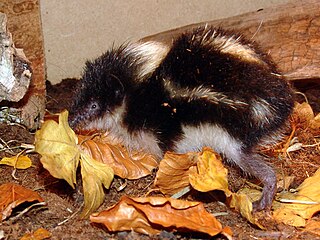
The highland streaked tenrec is an insectivore which lives in the central upland regions of Madagascar. Its black and white striped body is covered with quills, which it will raise when agitated. The spines detach and remain in the body of an inquisitive predator. The function of the black-and-white pattern may be to mimic juvenile Tenrec ecaudatus since the parents of this species are known to be aggressively protective, and the stripes may have developed as a type of camouflage while foraging. The highland streaked tenrec uses its long snout to burrow under leaves and bark, searching for earthworms, its primary food.

The tailless tenrec, also known as the common tenrec, is a species of mammal in the family Tenrecidae. It is the only member of the genus Tenrec. Native to Madagascar, it is also found on the Comoros, Mauritius, Réunion, and Seychelles island groups, where it has been purposely introduced. Its natural habitat is the understory of subtropical-tropical forest, open forest, arid shrub-land, savanna, arable land, pastures, crop plantations, private gardens, and some landscaped, urban areas.
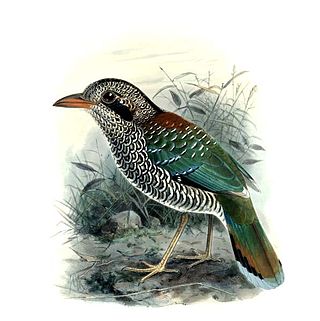
The scaly ground roller is a species of bird in a monotypic genus in the near-passerine family Brachypteraciidae. It is endemic to eastern Madagascar. Its natural habitat is subtropical or tropical moist lowland forest. The scaly ground roller is found at elevations below 1,000 meters (3,300 ft), and one of the few birds of Madagascar to reside in lowland rainforest.

The lesser hedgehog tenrec is a species of mammal in the family Tenrecidae. It is the only species in the genus Echinops and is named in honour of Charles Telfair. It is endemic to Madagascar. Its natural habitats are subtropical or tropical dry forests, shrubland, and shrubland and dry savanna.

Cowan's shrew tenrec is a species of mammal in the family Tenrecidae.

Jenkins's shrew tenrec is a species of mammal in the family Tenrecidae. It is endemic to Madagascar. Its natural habitats are subtropical or tropical dry forests and shrubland. It is threatened by habitat loss.

The pygmy shrew tenrec is a species of placental mammal in the family Tenrecidae. It is endemic to Madagascar. Its natural habitat is subtropical or tropical moist forests. While it is not endangered, its population is slowly declining as it is threatened by habitat loss. This is of concern, though does not yet merit a higher protection level.

The greater hedgehog tenrec, also known as the large Madagascar hedgehog or sokina, is a species of mammal in the family Tenrecidae. It is endemic to Madagascar. Its natural habitats are subtropical or tropical forests, shrubland and grassland, savanna, rural gardens, and urban areas.

The Central Highlands, Central High Plateau, or Hauts-Plateaux are a mountainous biogeographical region in central Madagascar. They include the contiguous part of the island's interior above 800 m (2,600 ft) elevation. The Central Highlands are separated from the Northern Highlands of the northern tip of Madagascar by a low-lying valley, the Mandritsara Window, which has apparently acted as a barrier to dispersal for species in the highlands, leading to species pairs such as Voalavo gymnocaudus and Voalavo antsahabensis in the Northern and Central Highlands. Species restricted to the Central Highlands include the Manavi long-fingered bat Miniopterus manavi and Miniopterus sororculus; the Betsileo short-tailed rat Brachyuromys betsileoensis and Voalavo antsahabensis; the Highland streaked tenrec Hemicentetes nigriceps and Four-toed rice tenrec Oryzorictes tetradactylus; and the Sibree's dwarf lemur Cheirogaleus sibreei. Because of the continuous habitat of the Central Highlands, there is little local endemism, unlike the Northern Highlands.

Tenrecinae is a tenrec subfamily endemic to the island of Madagascar. It contains the largest species in the family, Tenrec ecaudatus. All members of the genus possess spines, analogous to those of hedgehogs, for defense against predators.

The southern Congolian forest–savanna mosaic is an ecoregion that covers a large area of the southern Democratic Republic of the Congo and northeastern Angola. Its rich blend of habitats provides key insights into the biogeography of central Africa with the extensive climatic variation that it has been experiencing for the last 10 million years. The human population is not high.

The Cape York Peninsula tropical savanna is a tropical grasslands, savannas, and shrublands ecoregion in northern Australia. It occupies the Cape York Peninsula in Queensland, mainland Australia's northernmost point. It is coterminous with the Cape York Peninsula, an interim Australian bioregion.
